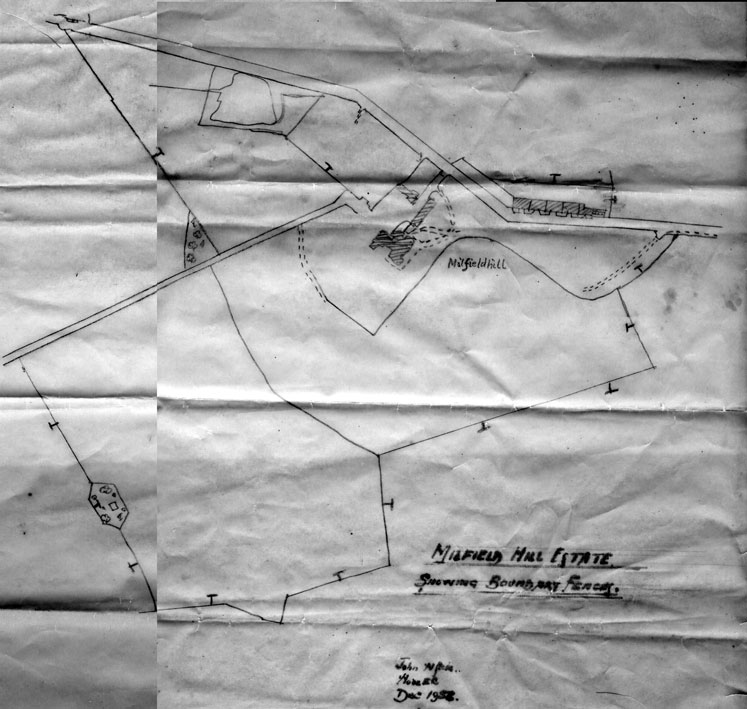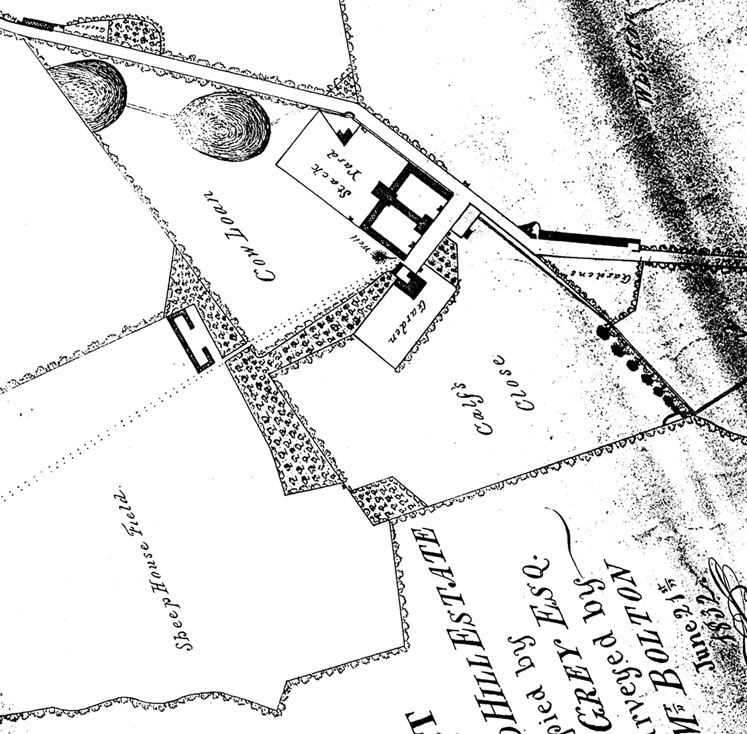
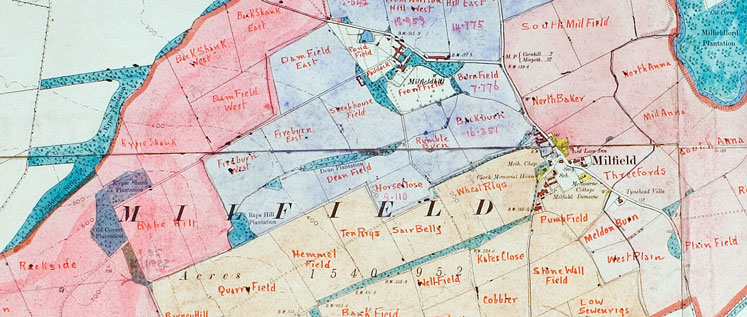
View Field Names in a larger map
A History of the Land going back to earliest times is recorded in "A History of Northumberland, Vol. XI, written in 1922. It can be read online here.
Page 243 "MILFIELD TOWNSHIP. Though to-day a township within the parish of Kirknewton, Milfield has not enjoyed this position from early times. (2) It finds no mention in any record earlier than the sixteenth century, and must have formed part of one or more of the neighbouring vills in early days. Its southern boundaries are suspiciously straight, so that it may have belonged in part to Lanton and Coupland, and some of it undoubtedly once formed part of Howtel Common.(3) It springs into notice at the same time as its neighbour Flodden, for it is first mentioned in the year before Flodden Field as the site of a considerable skirmish between Scots and English. In August, 1512, Alexander, Lord Home, on plundering bent, crossed the border with about 3,000 horse according to Scottish accounts, or seven or eight thousand, which is the English version. On their return they fell into an ambush carefully laid for them in 'a brome felde called Mylfeld' by Sir William Bulmer with a hastily levied force of something under a thousand men.'(4) Despite their stout resistance, a small force of professional archers turned the struggle in favour of the English, and many of the Scots were slain, five or six hundred according to the English account, and two or three hundred more taken prisoner, including George Home, Lord Home's brother. The
Page 244 Scots maintained that it was only their rearguard that was thus partially annihilated, and that the booty, which had gone before, remained in their hands, but the English report had it that ' the pray was reckned beside a great number of geldings.' 'This,' writes the southern chronicler, 'was the fyrst open token of warre shewed by the Scottes, whiche call this journey the yll Roade.'(1) Despite this disaster, the Scots three years later ' to the nomber of 400 men came into England to a place called Corkleche upon Mylnefield,"(2) which they used as their head- quarters from which to send forays, the most serious one being to Holburn. The English borderers, pursuing the returning forayers, were trapped by the Scottish main force at Milfield, and many of them were carried off prisoners to Scotland.(3) On the other hand Milfield was used in 1523 by the English borderers as a gathering place from which to make a raid into Scotland.(4) Only on one other occasion did the hamlet play a part in military' operations, when the Scottish army invaded England in 1640. In order to avoid Berwick, it crossed the Tweed at Cornhill, and making its way up the broad valley of the Till, lay on August 21st, its first night on English soil, at Milfield.(5)
Descent of the Property. — It is in the year 1541 that we get the first indication as to the owner of Milfield, when a survey of that year records : 'The towneshippe of Mylnefelde conteyneth vi. husband lands plenyshed without any fortresse or barmekyn and ys of th'inherytaunce of a wedowe late the wyfe of Mychaell Muschiens.'(6) This lady had died by 1658, when 'Oswald Muschiens' held the vill in capite.(7)' The whole township did not belong to this branch of the Muschamp family, since in his will made in 1542 Thomas Manners, first earl of Rutland, alludes to his property there. (8) In 1591 John Muschamp held lands and tenements in Milfield of Sir Thomas Grey, as of the manor of Wark,(9) and he was
PAGE 245 probably John Muschamp of Lyham Hall, whose wife Barbara was daughter of Eleanor Collingwood, widow of one of the Collingwoods of Etal.(1) This property was Milfield Hill, which Ralph Muschamp in 1616 leased to Thomas Unthank, who later held a mortgage on it. This Ralph Muschamp had a son and heir Robert, by his wife Eleanor, but in 1653 he sold Milfield Hill to Wiliam Lord Grey of Wark.(2) In 1584, too, John Collingwood, who also held land in Lanton and Branxton, was part owner of the vill,(3) and another share is mentioned in 1608 as belonging to Thomas Burrell of Milfield.(4) This Thomas was succeeded by his son Robert,(5) who in 1618 bought for £240 certain messuages, lands,etc., in the township from Henry Collingwood of Etal, Margaret his wife and George Collingwood of Etal, his brother.(6) In 1628, and again in 1638, among Northumberland freeholders appears the name of Robert Burrell of Milfield." In the Rate Book of 1663, Lord Grey was assessed on a rental of £80 and Mr. George Grey on one of £30.(8) The latter was the husband of Catherine, widow of Thomas Burrell, whose son Ralph succeeded, and in 1678 sued David Wake, Catherine's third husband, for an account of his property.(9) The Burrell portion was Milfield Ninths, which was sold in 1719 by Thomas Burrell of Broompark to Robert Blake of Twizel for £430,(10) and in 1722 James Wilson of Coupland and Robert Blake of Twizel voted for the township, being replaced by John Ord of Morpeth and James Wilson of Milfield in 1748.(11) According to the court rolls of Wark, Sir Henry Grey, as heir to Ralph, Lord Grey, to whom this portion of the Tankerville inheritance descended, Francis Blake and James Wilson held lands in Milfield of that manor in 1738 and 1759, but in 1764 John Ord took the place of Wilson, (12) though it is evident
Page 246 from the Poll Book that both these last held lands in the township in 1748. When in 1789 Milfield, otherwise Lanton, Common was enclosed, Sir Henry Grey received by far the largest allotment, amounting to 246 acres in respect of Milfield Hill, William Ord held Milfield Demesne and other lands, but received therefor only 87 acres, while Sir Francis Blake with 42 acres in respect of Milfield Ninths had the smallest allotment.(1) A portion of this last property, now known as the Manors, was sold in 1877 with Crookham, to which it lies adjacent, by Sir Francis Douglas Blake to the late earl of Durham, who bequeathed it to his second son, the Hon. F. W. Lambton.(2) The rest of the township later became the property of George Annett Grey, whose grandfather George Grey had owned Sandy house. (3) When this latter came to Milfield, 'the plain was still a forest of wild broom. He took his axe and, like a backwood settler, cut away the broom and cleared for himself a space on which to begin his farming functions.'(4) He farmed Milfield Hill, and on his death in 1793 his widow carried on his work, as his son John was only eight years old. John Grey grew up to manhood under the kindly inspiration of his neighbour George Culley, and he soon became a well known figure in the agricultural life of Northumberland. He was a great reformer, and championed such causes as parliamentary reform and the abolition of slavery, and, much to the surprise and horror of his friends and associates, was a constant advocate of the repeal of the corn laws. In 1833 he was appointed to take charge of the Greenwich Hospital estates, and he moved to Dilston. He never ceased to contribute largely to the agricultural literature of the time, working always on the principle that if agriculture was ever to rank with the other great sciences, 'the culture of the mind must precede that of the land.'(5) His son George Annett Grey bought Milfield Hill, of which he was already tenant, from Earl Grey in 1850,(6) Milfield Demesne from Charles William Orde in 1862,(7) and Milfield Ninths from Sir Francis Blake in 1877. The present owner of the estate is his great-grandson, Mr. John Neil Grey.
Page 246 Notes
(1)Milfield Hill Deeds.
(2)Crookhouse Deeds.
(3 & 6 ) Milfield Hill Deeds.
(4 & 5 )Memoir of John Grey of Dilston, by his daughter, Josephine Butler (London, 1874), p. 8.
(7) Milfield Demesne Deeds.
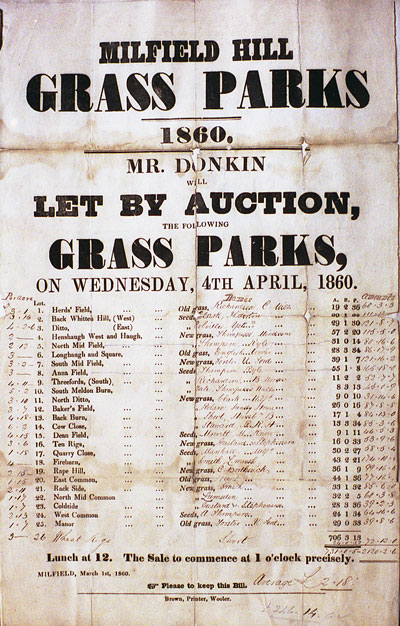
Page 243 Notes
(2) The Census returns are ; 1801,193; 1811,168; 1821,259; 1831,262; 1841,225; 1851,246;1861, 225: 1871,222; 1881,176; 1891,172; 1901,131; 1911 124. The township comprises 1540-952 acres.'
(3) There is mention of ' Le Milnefeld' as situated in Akeld and Akeld Strother in 1349 (Belvoir Deeds. drawer 2), but Akeld touches the modern Milfield at no point. Still there is a possibility that Milfield was known in the middle ages as Akeld Strother of which there is no other mention.
(4)The Scottish chronicler gives the number as 300.
Page 244 Notes
(1)Hall, p. 556 ; Buchanan, Book xiii. vol. ii. p. 131.
(2) This is doubtless Corkledge, a plantation beside the high road. It now lies in Coupland.
(3) October 12th, 1515. Relation of the Misdeeds of the Scots dated March 15th, 1516 — Raine. North Durham, p. i.x. ; Letters and Papers of Hen. VlII . vol. ii. pt. i. p. 470.
(4) Despatch from Surrey to the king, May 21st, 1523 — Raine. North Durham, p. x.
(5) Cal. of State Papers, Domestic, 1640, pp. 615-616, 621.
(6) Survey of the Border, 1541 — Border Holds, p. 34.
(7)' Liber Feodarii, 1568 — Hodgson, pt. iii. vol. iii. p. Ixx. The place is spelt '.Mytfield' but the identification seems fairly certain.
(8) North Country Wills, vol. i. p. 1S7.
(9) Inq. p.m. a Eliz., Thomas Grey, kt.— Lambert .MS.
Page 245 Notes
( 1) Will of Eleanor Collingwood, dated November 3rd, 1597 — Raine, Testamenta, vol. ii. p. 83.
(2) Milfield Muniments.
(3)Cal. of Border Papers, vol. i. p. 15.
(4) Moneys levied at Northumberland Assize 11th .August, 6 James I. — Waterford Documents, vol. i. pp. 57. 58.
(5) Lord Joicey's Deeds, vol. i. p. 53. He left his second son John his property in Slateraw in Ford.
(6)Newcastle Public Library, Coleman Deeds, iii. 22. By his will dated 9th November, 1603, Henry Collingwood of Old Etal left to his son George all his lands in Milfield. He mentions his wife Margaret. (Raine, Tetlamenta, vol. i. p. 41.) It seems as though he was still living in 1618, and that George Collingwood of the conveyance was his son not his brother.
(7)Freeholders of Northumberland, 1628, 1638 — Arch. Aeliana, O.S. vol. ii. pp. 321i, 323. Thomas Unthank of Milfield took a mortgage on a portion of the Ford estate in 1616. Lord Joicey's Deeds, vol. i. p. 55.
(8) Book of Rates, 1663 — Hodgson, pt. iii. vol. i. p. 278.
(9) P.R.O. Chancery Proceedings, Bridges, bundle 448, Nos. 116, 132 ; bundle 445, No. 117. See N.C.H. vol. vii. p. 223, where a pedigree of the family will be found.
(10)Milfield Muniments.
(11) Northumberland Poll Book.
(12) Lambert MS.
"Judging by the news from home, if you don’t come to Milfield soon there won’t be any woods left for us to walk through. Four big woods on the hill have gone since I was last there and more are likely to go. The woods round the house are still intact and so is the most distant one, a very exciting mysterious one called the Badger Wood. Years ago I should have been very upset about the loss of these woods but it doesn’t seem to worry me now-a-days. One’s sense of values changes after five years of war". Robert Grey 1944
The "badger wood" was probably the wood marked on the above map as "Old Covert Plantation". It was on the left as you walked up the hill. As can be seen from a comparison of today's satellite photograph with the old estate map the wood called Kypie Shank Plantation has gone, and may be one of the four that Robert refers to in his letter.
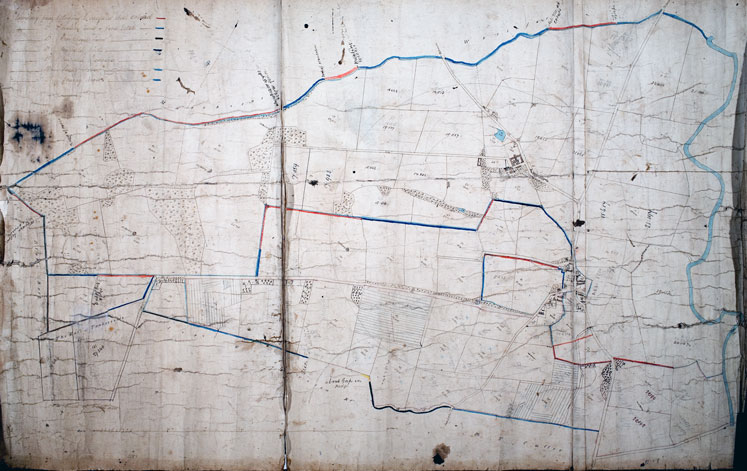
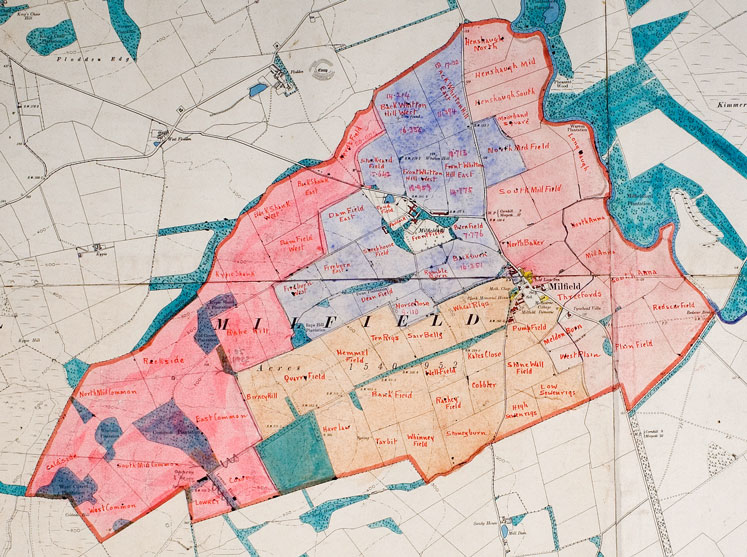
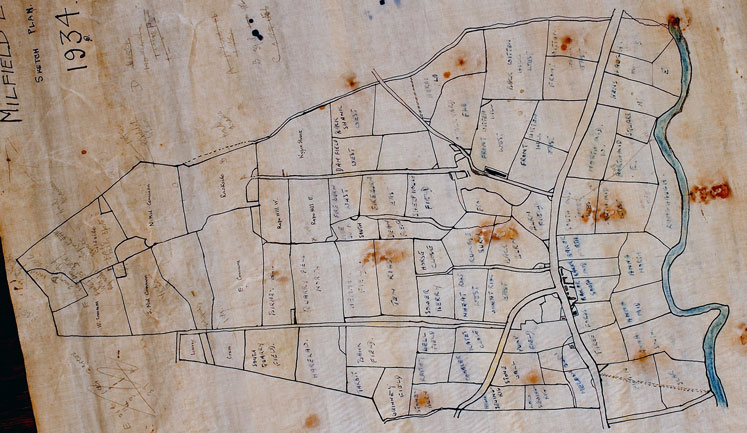
George Annett Grey bought Milfield Hill, of which he was already tenant, from Earl Grey in 1850, Milfield Demesne from Charles William Orde in 1862, and Milfield Ninths from Sir Francis Blake in 1877.
The poster for the grass park lets in 1860 shows the names of the fields that belonged to Milfield Hill before George owned the other two farms.
